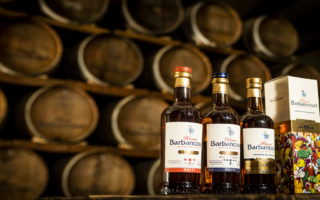Classic cuisine: chocolate truffles
Chocolate truffles were invented by chance but are now an indulgent fixture of the Christmas festivities
In 1895, a Chamb�ry chocolatier named Louis Dufour failed to receive a delivery just before Christmas, so he concocted a ganache with cream, cocoa powder and vanilla, and then dipped rough balls in melted chocolate and cocoa. Whimsically named ‘crottes de chocolat’, which roughly translates as ‘chocolate droppings’, the sweets later earned a more elegant name inspired by their resemblance to the precious tuber melanosporum, or black truffle.
Sold in just about every chocolate shop, from the pedestrian to the posh, the truffle retains a childish appeal. This might explain its continuing popularity at Michel Chaudun’s chic Paris boutique, a kind of gingerbread house for grown-ups with its gleaming wood fa�ade, pristine rows of ganaches and unabashedly kitsch collection of chocolate figurines.
His clientele of celebrities, politicians from the nearby Assembl�e Nationale and chocolate-lovers snaps up the dice-sized truffles, known here as pav�s (paving stones). In nearly 50 years as a chocolatier, Chaudun – who refuses all modern innovation, even the Internet – has always retained his fondness for this simplest of chocolate creations, which he makes with meticulous attention to detail.
Part of the truffle’s charm is that even a child can follow the recipe, but, as Chaudun points out, every ingredient and every step counts: this is what makes the difference between his melt-in-the-mouth truffles and the paste-like sweets that are sometimes sold in lesser shops.
A superior truffle, not surprisingly, begins with high-quality chocolate. “Use a good couverture, not ordinary chocolate,” says Chaudun, who names Weiss, Valrhona and Barry as reliable brands. Couverture contains more cocoa butter than other chocolates, which makes it smoother in the mouth and easier to work with. To personalise your truffles, experiment with chocolates of different origins and strengths. The higher the percentage of cocoa solids, the more intense it will taste.
The cream and butter may play secondary roles, but they are just as important. Chaudun uses a cream with 34 per cent butterfat and butter from Poitou-Charentes that has a distinctive flavour similar to that of the more expensive Echir� produced in the same region. Vanilla from Madagascar is a classic flavouring, but you could substitute other spices or infuse the cream with herbs, ginger or orange zest.
Temperature is crucial. To create a smooth ganache, both the butter and chocolate should be at room temperature. Chaudun also has a specific method for heating the cream: he brings it to a brief boil three times rather than cooking it steadily. “When you let cream cook on the stove for a minute, you can’t predict how much it will evaporate,” he explains. “With this method you get a consistent result.”
During this process, Chaudun avoids whisking the cream, so as not to incorporate air into the ganache. The chocolate and butter should melt in contact with the hot cream; if this does not happen because one of the ingredients was too cool, you will need to heat the mixture to between 35�C and 38�C.
Rather than form balls with the ganache, Chaudun pours it into a tray to a thickness of around 1.5cm. Once the ganache has set in the refrigerator he cuts it into small squares using a mandoline, but a sharp knife heated under hot water also works. Then it is up to you whether to dip the truffle in melted chocolate and/or roll it in cocoa. Whichever you choose, savour a few before they vanish like freshly fallen snow.
By Rosa Jackson
Michel Chaudun’s Truffle Pav�s
Makes about 1.2kg of truffles
• 300ml / 1� cups double cream
• � Bourbon vanilla bean, split in half lengthways
• 400g / 14oz dark chocolate with at least 70 per cent cocoa solids
• 70g / 2�oz butter, preferably Poitou-Charentes, at room temperature
Optional
• 300g / 11oz chocolate with no more than 60 per cent cocoa solids, for dipping
• 200g / 7�oz unsweetened cocoa powder
Share to: Facebook Twitter LinkedIn Email


